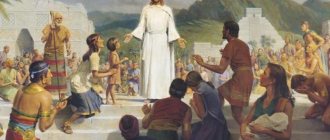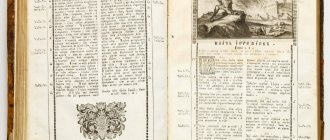| Septuagint, Codex Sinaiticus (fragment), Book of Esther, 2:3-8 |
Septuaginta
,
translation of the seventy
,
LXX
, the first Greek translation of the Old Testament, made during the 3rd century. BC. The Old Testament in this translation played a huge role for the Church. It was used by the apostles, New Testament writers and holy fathers. The first translation of the Old Testament into Church Slavonic was also made from it. The collection of sacred books of the Septuagint was included in the Alexandrian Canon.
Origin of the Septuagint
The earliest evidence of the Septuagint is the Epistle of Aristaeus, which preserves one of the legends about how this translation was created. The author of the message claims that the translation was commissioned by the king of Hellenistic Egypt, Ptolemy II Philadelphus (285-247 BC), who wished to have the Greek text of the Jewish Law in his library in Alexandria. For this purpose, he ordered 72 interpreters (scribes) from Jerusalem, who, settling in the house provided to them on the island of Pharos, completed the work in 72 days. The text was called the “Translation of the Seventy Interpreters”
(symbol LXX). The Epistle of Aristeas speaks only of the translation of the Pentateuch. But, as is clear from the Greek preface to the Book of Wisdom of Jesus, son of Sirach, at the end of the 2nd century. BC, the Septuagint already included “The Law, Prophecies and other books.”
The message records only one version of the legend that developed around the Septuagint. For example, there was a legend according to which each translator worked on the entire text while in an isolated cell, but everyone’s translation turned out to be identical. This is where the idea of the Septuagint being inspired by God arose, which was shared, in particular, by Philo of Alexandria. However, Blessed Jerome decisively rejected this idea. “It is another thing,” he wrote, “to be a prophet and another to be a translator” (Against Rufinus, II, 26). He directly regarded the legend about the cells as a fable. However, neither he nor the other fathers and teachers of the Church doubted the authenticity of Aristaeus’ story.
From the 16th century The message was recognized as a pseudepigrapha. The reason for the creation of the Septuagint received a different light. Apparently, it arose due to the practical needs of the Jews of the Diaspora, many of whom began to forget their fatherly language. Missionary motives also played a certain role here. Nevertheless, in modern bibliology, after a period of skepticism, confidence in the main facts set forth in the Epistle has been established.
Initially, the Septuagint enjoyed great authority among the Jews of the Greek-speaking diaspora. Philo in “The Life of Moses” (11:41-42) even talks about the annual holiday that they organized on the island of Pharos in memory of the feat of seventy interpreters. But in the AD Jews had already begun to view the Septuagint with suspicion due to the disagreement of many of its passages with the Hebrew text. These discrepancies have caused controversy in the Christian world for many centuries. Often even a hypothesis was put forward about the deliberate corruption of the text by Jewish scribes. However, after the discoveries at Qumran, it became clear that during the era of the creation of the Septuagint, there were many parallel versions of the Hebrew text and the Septuagint reflects only one of the manuscript traditions.
Used materials
- “Bibliological Dictionary” by priest Alexander Men
The Old Testament was translated into Greek quite early. This translation is called the translation of the Seventy (LXX), or Septuagint
(
Septuaginta
seventy
in Latin .
The basis for this name lies in the legend about the origin of this translation. They say that the Egyptian pharaoh Ptolemy II Philadelphus (285 or 282 - 246 BC), having learned from Demetrius of Phaleron, who was in charge of the royal book depository, about the existence of the Scriptures of Moses in Judea, decided to organize the translation of the Law into Greek and the delivery of books to Library of Alexandria. To this end, Ptolemy sent a letter to the Jerusalem high priest Eleazar: “Wanting to please all the Jews living on earth, I decided to begin translating your Law and, having translated it from Hebrew into Greek, place this book among the works of my library. Therefore, you will do well if you choose six elderly men from each tribe, who, due to the length of their studies in the laws, are very experienced in them and would be able to translate it accurately. I believe that this work will earn me the greatest glory. Therefore, I am sending you for negotiations regarding this […] Andrei and Aristaeus, who both enjoy the greatest honor in my eyes.” And then 72 people (or 70) settled on the island of Pharos, where each one translated the entire text of the Pentateuch alone within 72 days; and, although the translators were isolated from each other, all 72 texts (or 70) were found to agree verbatim ( Philo.
Vita Mosis.2;
Josephus Flavius.
Antiquitas Judaeorum.XII.2;
Irenaeus.
Adversum haereses.III.15;
Clementus Alexandrus.
Stromata.I - II).
This entire story is based on a work known in literature as the Letter of Aristaeus to Philocrates
, the falsity of which is currently beyond doubt. (It was compiled no earlier than the middle of the 2nd century BC.) In fact, the history of the Septuagint is different. In the last centuries BC there was a colony of Jews in Alexandria. They forgot their native language, and Greek became their language, so that the original text of the Tanakh became inaccessible to them, and a need arose for its Greek translation. Therefore, translations of various Old Testament books gradually appeared, resulting in the Septuagint. Probably, the complete translation was carried out only in the 1st century. BC. And the composition of the books of the Septuagint, including the so-called deuterocanonical books, was formed no earlier than the 1st century AD.
History of the text
Over the centuries, the text of the Septuagint itself has undergone a number of changes. They appeared soon after Origen compiled his Exapl. Origen included in the Septuagint the words omitted by the scribes from the Hebrew original, using Theodotion's translation for this. He marked the insertions with special marks, but in subsequent copies they were omitted and thus the text of the Septuagint was mixed with the Theodotion version. At the beginning of the century There were three main reviews of Origen's text of the Septuagint in circulation: a) Caesarea, belonging to the master Pamphilus of Caesarea and Eusebius of Caesarea, b) Antioch, the master Lucian and c) Egyptian, Hesychia.
Translation or gag?
In principle, the situation with translating the Bible is no different from translating any other text: you can try to convey the meaning of the original as accurately as possible, you can distort it, or you can deliberately obscure it.
Generations of translators tell the story about that interpreter, thanks to whom they managed to avoid an international scandal: when Khrushchev at the UN promised to “show the imperialists Kuzma’s mother,” he conveyed his words verbatim... and therefore completely colorless and incorrect: “we will show them Kuzma’s mother.”
English-speaking listeners, naturally, did not understand what was so special about the mother of Mr. Kuzma, unknown to them, but, in any case, they were not offended by the outright rudeness of the Soviet leader.
This is how the Bible is sometimes translated. Leo Tolstoy, for example, created his own version of the Gospel in order to bring the sacred book closer to the people. But at the same time, he did not limit himself to conveying the idea of the original in a simpler language - he changed the original itself, throwing out all the miracles from it, for example, the resurrection of Christ. Tolstoy's Christ is a moralist, like Lev Nikolaevich himself, and nothing more.
This is, of course, an extreme. Few translators make such a conscious change to the text... But something else is possible: an inaccurate understanding or even a conscious adjustment of the original to the translator’s ideas about it. And how do you know how much you can trust a new translation?
Manuscripts and publications
| Leather scroll of the Septuagint containing fragments of the books of the minor prophets. Dated between 50 BC - 50 AD The Tetragrammaton (יהוה, indicated by an arrow) was not translated, but retained in Hebrew writing |
The oldest manuscripts of the Septuagint are fragments of Egyptian papyri of the 3rd-2nd centuries. BC, i.e. modern to the translation itself. It is noteworthy that the sacred Name of God (Tetragrammaton) is written in them not in Greek, but in ancient Hebrew letters. Later the Tetragram in the Septuagint was replaced by the word "Κυριος", Lord. The most complete lists of the Septuagint of Christian times are presented by the Sinaiticus, Vatican and Alexandrian codes. The first printed editions of the Septuagint appeared in the 16th century. (Complutensian polyglot of Jimenez 1514-1517; Roman edition 1586; Aldine Bible 1518-1519). All of them were guided by Exaples and the Vatican Codex. After new discoveries at the turn of the 19th century. the number of known ancient Septuagint manuscripts increased. An international commission was created to prepare a critical edition of the Septuagint (Professor I.E. Evseev took part in it from the Russian Orthodox Church). The publication was published in Stuttgart under the editorship of Ralphs (1935) and was subsequently reprinted several times.
Features of the Septuagint
A number of biblical books received new names in the Septuagint (books of the Pentateuch; 1-2 books of Samuel, called 1-2 Books of Kings; Books of “Deeds of Past Days,” called Books of Chronicles). The volume of the Septuagint adopted in the Alexandrian Canon is significantly larger than the volume of the Hebrew Bible. The Septuagint includes a number of books and episodes classified by the Church as non-canonical writings. Almost all names and place names received a different form in the Septuagint in accordance with the norms of the Greek language (for example, instead of Chava - Eve, instead of Noah - Noah, instead of Moshe - Moises, instead of Shiloh - Shiloh, etc.). A number of gaps in the Hebrew text were probably filled in by Greek translators according to the meaning (for example, in the Hebrew “And Cain said (told?) Abel his brother. And when they were in the field, Cain rose up against Abel his brother and killed ero"; in the Septuagint: "And Cain said to Abel his brother: Let us go into the field. And while they were in the field...", etc.). The translators of the Septuagint drew attention to the alternation in Genesis of the Names of God Elohim and Yahweh and almost everywhere they added the word God to the name of Yahweh, designated by the word “Lord.” Often the Septuagint more accurately conveys the original meaning of the text. Thus, in Am 4:13, instead of “mountains,” the Greek translator put “thunder,” which is more consistent with the context (the error of the Jewish copyist arose, apparently, due to the similarity of the words haram, mountains, and harabm, thunder). The conditions of the pagan environment probably explain some of the features of the translation. For example, the words in Exodus 22:28 “Do not revile God” are rendered as “do not revile gods” (another option: “do not revile rulers”). The Septuagint is characterized by an abundance of Semitisms. “The authors of the translation of the Seventy adhered to the method of utmost fidelity to the Hebrew text, no matter how much the Greek language suffered from this, except in those cases when this departure from the Greek rules seemed to them excessive or the Hebrew expression too crude” (Tremontan).
Translations of different books differ in their accuracy and literary merits. If the Pentateuch is translated quite closely to the text, then, for example, the Book of Job and the Book of Proverbs are rather free transcriptions. In general, the translation has high artistic merit. “The creators of the Septuagint managed to create an organic fusion of the Greek and Semitic linguistic systems; their style is close to colloquial expressions and yet invariably retains sacred elation and “detachment”” (Averintsev).
In the Russian Orthodox Church, the Septuagint is considered one of the most authoritative translations. There was a tendency to canonize it, just as Catholics canonized the Vulgate (Metropolitan Philaret (Drozdov) opposed this). There were even voices that the Old Testament should be translated into Russian only from the Septuagint. However, neither the translators of the Russian Bible Society nor the participants in the Synodal translation followed this path. Although the Synodal translation took into account the Septuagint, it was based on the Masoretic text.
Forever new book
The Bible is the most translated book in the world. Even Marx and Lenin in Soviet times could not match it in terms of the number of translation languages. At the same time, there are still many languages that do not have the full text of the Bible or at least the New Testament, and among them are the vast majority of the languages of the Russian Federation. Actually, the main work of the author of these lines is to help people from these nations create their own national version of the Bible.
But why are more and more new translations appearing in those languages into which the Bible has long been translated? There are already several hundred English Bibles; the Russian versions of the New Testament also number in the dozens... Why?
Partly due to the heaviness and archaic nature of the old translations, in our case the Synodal, the language of which is sometimes called “pre-Pushkin”. And in fact, it began to be created in the first half of the 19th century. Consider such outdated words as “seat” (seat, throne) and “vagina” (sheath), or such florid phrases: “the visions of my head on my bed were like this” (Dan. 4:7). Why not simply say: “this is what I dreamed”? Sometimes the old translation is completely incomprehensible. “Because of Thy rebuke, O God of Jacob, both the chariot and the horse slumbered” - this is how the 7th verse of the 75th Psalm sounds in the Synodal translation. You won’t immediately realize that we are talking about Israel crossing the sea, when, by the will of God, the Egyptians fell into eternal sleep at its bottom along with their war horses.
Science also does not stand still; new, updated data is constantly appearing, which allows us to correct possible inaccuracies in old translations. Moreover, no translation can express all the possible subtleties of the original.
But this is not the main reason. The world is changing, the reader is changing. Many expressions of ancient and simply old translations, even if they are generally understandable, do not touch the hearts of new generations the way they once touched the first readers. After all, words sometimes become so dilapidated that we cease to perceive their essence. And new translations often aim to “refresh the perception” of the biblical text.
Here, for example, is how the ministry of John the Baptist is described in the Synodal Translation (Matthew 3: 1-6): “...John the Baptist comes and preaches in the desert of Judea and says: Repent, for the Kingdom of Heaven is at hand... and they were baptized by him in the Jordan, confessing their sins."
And here’s how the new translation of “The Good News” says it: “...John the Baptist appears. He proclaims: “Turn to God! After all, the Kingdom of Heaven is already at hand!”… They confessed their sins, and he washed those who came in the Jordan River.” Excuse me, where is the sermon, repentance, baptism? Yes, the fact of the matter is that, according to the translator, these words are too familiar to us and are often associated only with formal rituals, and people need to be reminded of the original meaning of these events.
How legal is this? Apparently, the answer to this question depends on the specific situation. Of course, for a person rooted in tradition and accustomed to recognizing an eternally new essence behind long-familiar words, such a translation looks shocking, and he does not need it. But perhaps someone opens it and for the first time understands that the Gospel is not just such an ancient Greek word, but real Good News for all times and peoples.
Literature
- Averintsev S.S., Greek literature and the Middle East. “literature”, in the book: Typology and interconnection of the literature of the ancient world, M., 1971;
- Averintsev S.S., Origins and development of early Christ. liters, IVL, 1983, vol. 1;
- Deryugin F., LXX or Jewish text? St. Petersburg, 1911;
- prot. Eleonsky N., Evidence of the origin of the LXX translation and the degree of its reliability, CHODP, 1875, No. 1;
- Zelinsky F., Aristeus, EE, vol. 3;
- archim. Joseph (Bazhenov), Historical. information about the translation of LXX, DB, 1860, No. 34-35;
- Korsunsky I. N., Translation LXX. Its significance in Greek history. language and literature, Serg. Pos., 1898;
- Myshtsyn V.N., Do we need Greek. lane Bible during the existence of Heb. original? Serg. Pos., 1895;
- Copyist error as one of the probable reasons for the disagreement between the original text in the Bible and the translation of the LXX in its present form, CHOLDP, 1878, No. 1;
- Assumption about the origin of certain differences between the LXX translation and the original text of the Bible, ibid.;
- Prozorovsky D., On the chronology of 70 interpreters, “The Wanderer”, 1862, No. 1;
- Rizhsky M.I., Job of the Septuagint, in the book: Bakhrushin Readings, Novosibirsk, 1974;
- Ep. Feofan (Govorov), About our duty to adhere to the translation of 70 interpreters, DC, 1876, part II, No. 5-8;
- Metropolitan Filaret (Drozdov), O dogmatic. dignity and protective use of Greek. LXX interpreters and glories. translations of St. Scriptures, M., 1858;
- Yungerov P. A., General historical-critical. introduction to the priesthood dilapidated books, Kaz., 1902;
- Brock S., Fritsch S., Jellicoe S., A Classified Bibliography of the Septuagint, Leiden, 1973;
- etc. foreign bibliogr. see JBC, v. 1, p. 574.
Tailored to the reader?
It must be said that translations of this kind began to appear all over the world only in the second half of the 20th century. A huge role here was played by the fact that the Bible began to be actively translated into numerous languages of the peoples of Africa, Asia, and Oceania.
Before this, until the 19th century, translations, with rare exceptions, were made either into Indo-European (like Greek) or Semitic (like Hebrew) languages. And those languages that did not belong to these two families (like Coptic or Finnish) experienced enormous influence from their Indo-European neighbors.
The structures of these languages were quite close - this can be seen in the example of the Slavic translation, which was done from Greek. Both languages had a similar system of declension and conjugation; even new Slavic words could be formed according to the same scheme as Greek. Even more important than the linguistic community was the cultural community. Of course, Greeks and Slavs or, say, Georgians are far from the same thing, but these peoples lived side by side for centuries, communicated and had many common concepts and ideas.
Now imagine a tribe living in the Amazon jungle or on an island in the Pacific Ocean. The language of this tribe is radically different from all Indo-European ones, and in its life and culture there is not only nothing in tune with biblical concepts, but also such familiar realities as stone buildings, woven clothing and even baked bread. How, for example, can an expression like “The Lord is my shepherd” be translated into this language if there were no shepherds in this tribe? Or how to convey the concept of “Lamb of God” if none of the readers have ever seen sheep, and there is no word for the One God in his vocabulary? How can people who are familiar only with the tropical forest, where there is no drought, but heavy rains for several months in a row, imagine “streams of living water”? Naturally, in this case, literal translation is simply impossible; it is necessary to convey the meaning of these images and metaphors, adapting to the everyday life and ideas of the audience.
Thus arose a new approach to biblical translation, which is called “semantic” or “dynamic”. And it is not surprising that gradually a similar technique began to be applied to languages into which the Bible had long been translated. And although a modern European or American is familiar with the biblical world much better than an Indian or Papuan, for him the old translation has often long ago turned into just a familiar form, behind which he no longer sees any special content. It is not the letter that needs to be translated, but the meaning of the text, believe supporters of this approach.









